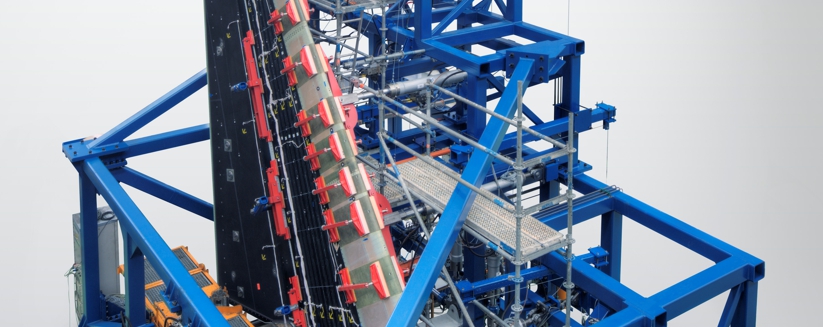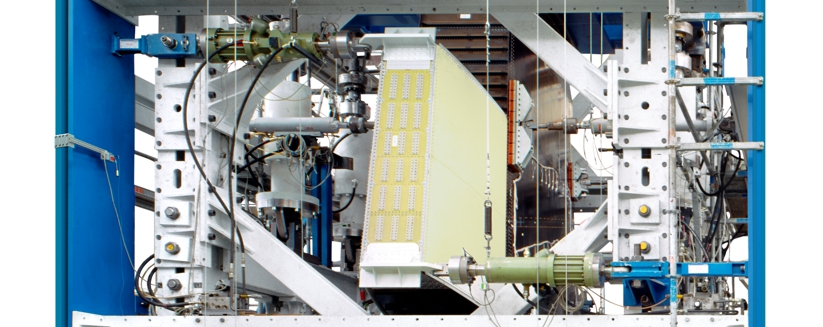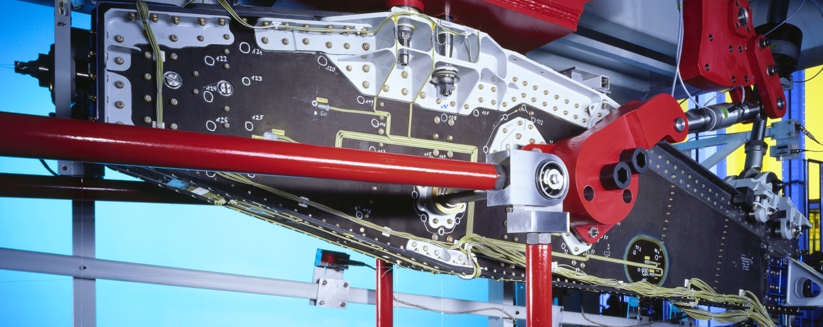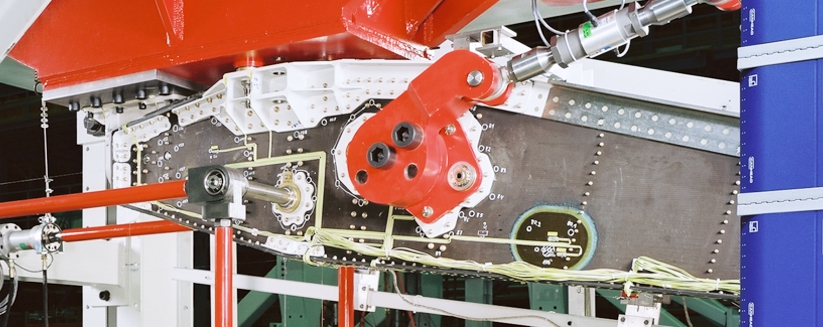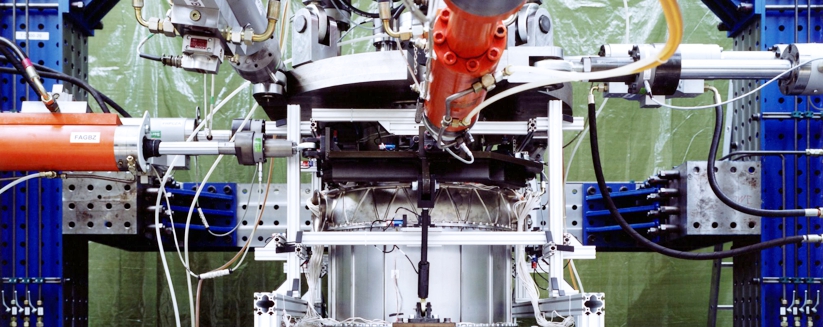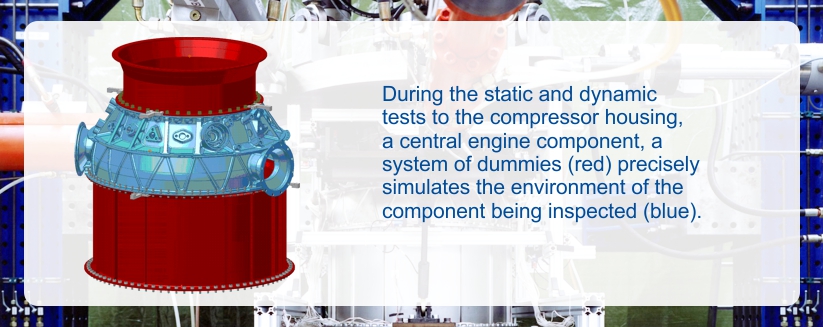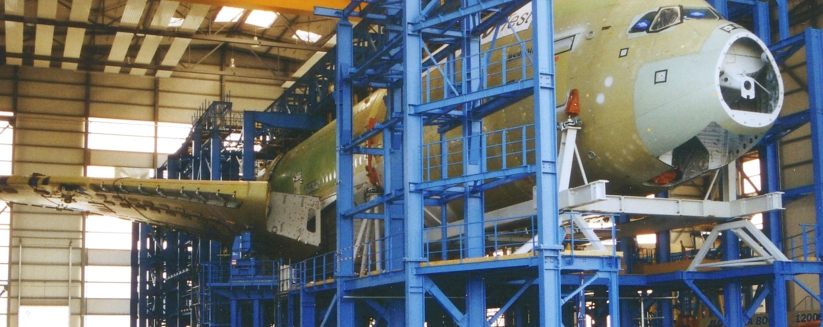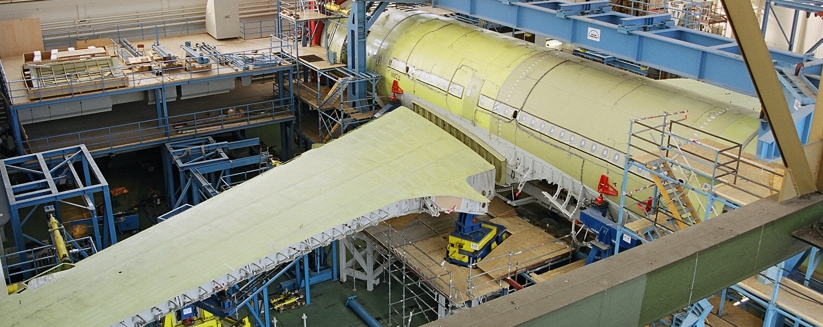The number one address for structural and material testing in the aerospace industry
A strong aviation industry requires a performance-capable and reliable partner who can be relied on completely for the development of aircraft structures and components commencing with an idea and through to serial production.
IMA Dresden is an internationally recognised and accredited partner of the aviation industry and supports the development departments of manufacturers and suppliers throughout the entire development of a product in order to verify its durability, function, and safety. For this purpose, IMA engineers test, simulate or compute the respective design and structural groups of an aircraft or helicopter such as e.g. fuselages, supporting constructions, tail units, landing gears, engines, and interior components). With such tests, we offer possibilities to experimentally examine different influences on the strength, to compare material use and design principles, and to verify calculation methods.
Irrespective of whether for verification of service life or for the approval of the aircraft component, all tests are executed at IMA Dresden in compliance with the relevant quality standards and the requirements of the approval or permission regulations. The latest test Technologies and test benches have supported the development of structures and entire aeroplanes for the entire Airbus family. Many international aircraft manufacturer for passenger aircraft, cargo planes, private jets and helicopters have now been added to the portfolio.
You can rely on us: our laboratories are certified according to DIN EN 9100, accredited according to ISO 17025 an accredited according to NADCAP for material testing and inspection of metals and non-metallic materials. This therefore ensures that we can always provide tailor-made solutions for a wide range of structures and test requirements.
Our portfolio
Component testing – From element to full-scale
Irrespective of whether you require drop tests of the chassis structures, fatigue tests on landing flap components or pressure tests on door components – we examine every desired component with our component examinations. We not only implement computational and theoretical but also experimental simulations for static and dynamic loads on your component, develop test concepts and individual testing devices and elements for load introduction.
Depending on the characteristics and properties of the test body, the material and the framework or boundary conditions which affect the structural unit, we will jointly create a test programme with you and then support you for selecting the correct load parameters and characteristic values such as, for example, natural frequencies. We also provide certification trials for the new approval processes.
Once the entire approval process has been finalised, an aircraft model can be produced reliably and safely over many years. Improvements to the material or manufacturing technologies therefore continuously flow into the production process.
In order to verify that modifications on the structures continue to demonstrate the fulfilment of the approval requirements, we can provide qualification trials and development trials for you. In this case we can provide you with the opportunity to satisfy service life statements or to test new designs on structural units. Repair solutions can also be tested for durability, resistance and strength.
We can provide a complete service for all experimental tests, examinations and studies:
- Test consultancy, advice for approval process and development of the test concept
- Project Management
- Logistics Services
- Designing and setting up the test facility, implementation of the trial
- Inspection, non-destructive testing, measurement value recording
- Assembly and dismantling the test object
- Creating test reports
and also
- Introducing prior damage (e.g. impact)
- Strength and resistance verifications and simulation
- On-site service
Minor damage as a result of fatigue or external influences are not forbidden in aviation lightweight construction, rather more an integral part of the safety concept. We investigate when and where component deformation and damage may occur, how they increase, which residual strength or resistance remains and how a structure reacts to, for example, to cyclic loads after an impact. Our specialists for non-destructive testing (NDT) will support you with the best respective, suitable procedures during the trial. In addition to the trial, we can provide among other things, high-speed recordings and photo-optical deformation, elongation and strain measurements.
Landing gear systems
Irrespective of whether this is the main chassis gear, nose landing gear or support landing gear (nose landing gear, centre landing gear or main landing gear) – our tests support you with the approval and development of chassis systems or their individual structural components.
To experimentally determine the service life of chassis systems, we provide static trials and dynamic fatigue trials in which the loads that occur during operation can be simulated is a realistic manner. These include, for example, maximum descent and landing speeds with maximum loading of the aircraft or the simulation of all landing procedures and other chassis or landing gear loads which occur during the service life of an aircraft. The day-to-day landing procedure for an Airbus A340 can introduce weights of up to 190 tons on the landing gear.
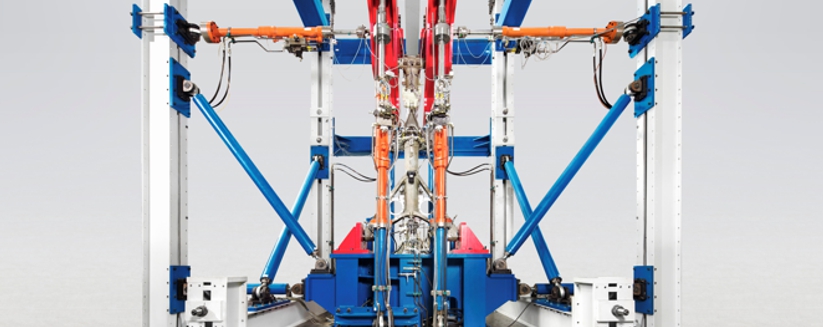
Our strength, resistance and endurance trials provide you with security for the approval process and, with our expertise and experience, we can assists you to improve your landing gear and to qualify it according to the valid approval regulations (EASA, FAA, …), irrespective of small aircraft, regional jets or large aircraft.
We can load the structural components such as housing, thrust tube, sidebars, wheel axles, interlocks, buckling struts and brakes individually or in a system.
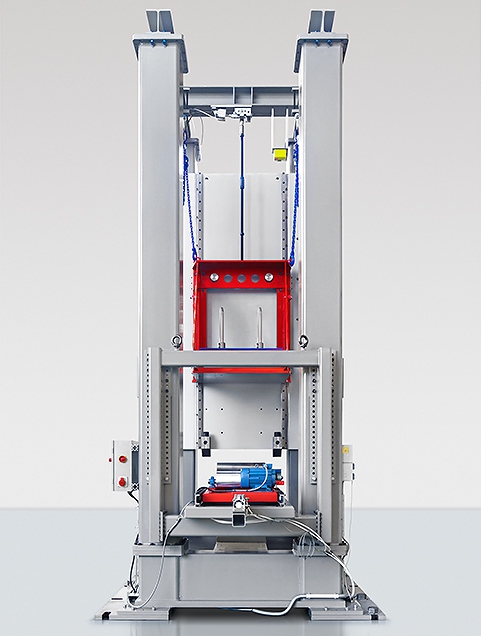
Complex special test bench for landing gear drop tests:
– Multiaxial landing platform
– Multiaxiale interface loads
– Different drop heights and descents speeds
– differential landing masses and speeds
– High-speed measurements
– Video recording
Tail Units
Tail unit and rudder structures play a central role in the development and qualification of modern aircraft systems. Questions relating to optimum technical solutions hereby play a major role in the context of development and approval certification trials for metallic, fibre composite and hybrid structures. Based on our extensive experience, we can provide our customers with solutions which are tailored specifically to the questions you have.
Fuselage
The aircraft fuselage, also called the cell, is a permanent development field – modern jointing technologies, material substitutions or novel requirements regarding fuselage geometry and fuselage design lead to new technical concepts. We can hereby provide tailor-made experimental and numerical solutions in qualification and development processes – from individual structural components to fuselage shells up to, and including, the whole cell.
Aircraft fuselage sections
Instead of time-consuming and cost-intensive barrel tests, we can provide the optimal test procedure, the shell test. Rather than examining the whole fuselage cross sections, we hereby examine curved cut-outs (shells) and therefore create the necessary boundary conditions. The multi-axial and continuously applied cyclic loads on the flat landing gears precisely create reality: the pressure difference between the cab and the environment and mass-related and movement-related tensile, compressive and shear stresses or loads.
Testing of curved fuselage panels
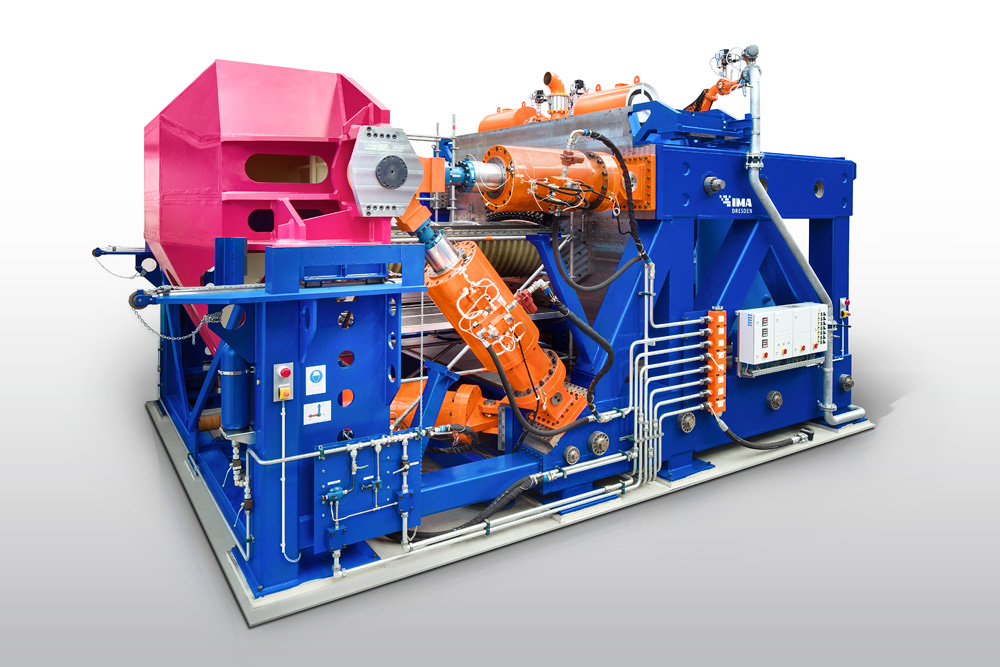
Our test bench enables examinations on shells from all areas of the fuselage. We can therefore simulate internal pressure and the resulting circumferential loads, tensile and pressure loads in the longitudinal direction as well as thrust loads. Distributed longitudinal and thrust loads or stress e.g. from transverse force and fuselage bending can therefore be simulated in the circumferential direction.
Possible configuration of load Parameters:
- Internal pressure: up to 1500 mbar
- Longitudinal force Fx: +/- 5000 kN
- Thrust force Fy: +/- 1500 kN
- Torsional torque: +/- 4000 kN
- Bending torque: +/- 10000 kN
Depending on the location in the fuselage, various, quasi-homogeneous sectional load conditions occur. Whether shells made of aluminium, CFC, FML or GLARE®, whether upper, lateral or lower shells, whether start-up phase, flight at maximum height or landing – our shell tests simulate every required relevant load. Our systems are designed as modular and can therefore be adjusted to different geometries for the fuselage shells.
Structural Elements (Stringer, Panels, Fittings)
Whether stringer, frames or panels – we utilise standard testing machines, which we have aligned with special adapters for the respective task, for implementing individual trials or series of tests. For individual and complex trials, we can design and construct special testing equipment. We have performance-capable measurement and control technologies available for static and dynamic trials. Utilising insulated chambers enables us to implement tests under temperature influences between -55 °C and +90 °C.
Panel tests
We can utilise our panel tests to flexibly implement fundamental examinations on component proximity (often levels) elements of the fuselage structure.
Included in these panel tests are:
– Samples of different materials, manufacturing processes and configurations
– Samples of variable geometry, parameters, coefficients and number of stringers and frames
– Examining the effects of artificial damage (e.g. crack development) and repair solutions
– Loading the samples with single or overlapped tensile, compressive and thrust forces
Frame Bending Tests
Our frame bending trials and tests enable us to flexibly provide fundamental examinations for partially complex assemblies and components of the aircraft fuselage structure, which often occur in reality.
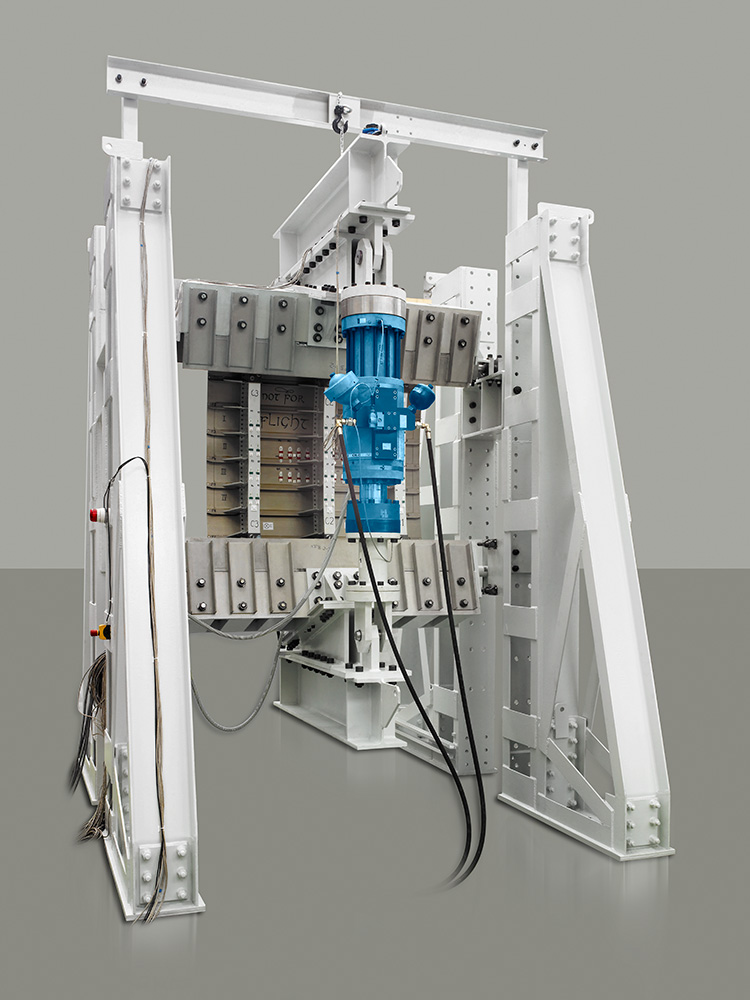
In Focus:
– Samples of different materials, manufacturing processes and configurations
– Samples of variable geometry, parameters, coefficients and number of stringers and frames
– Examinations for the effects of artificial damage (e.g. dents, films and delamination)
– Loading the samples with constant bending torque in the cross-section
Aircraft Doors
Irrespective of whether passenger doors or cargo doors, composite technology or cast aluminium- we can provide statements for service life, strength and resistance with our product development trials and approval tests. We hereby provide endurance tests, damage tolerance tests, fail-safe examinations and static tests up to a differential pressure of 2 DeltaP.
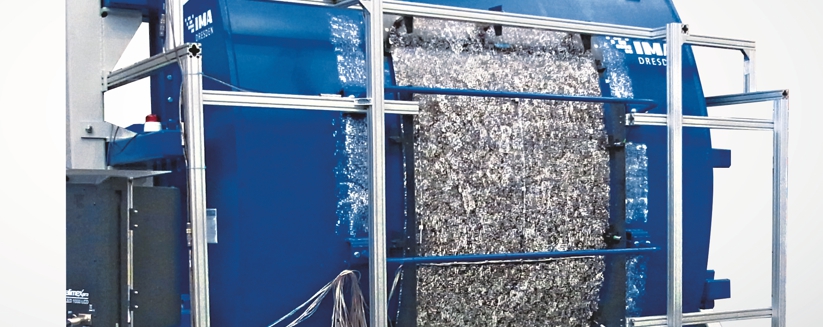
Fuselage Barrel Test
In addition to shell tests, we also examine fuselage sections with lengths of several metres, so-called barrels. The subject matter of these tests are the fatigue and damage tolerance behaviour. We conceive and implement the test structure (CAD model on the left) for this purpose. All load components such as the longitudinal forces, transverse forces, bending, torsion and internal pressure will be applied either statically or dynamically in the form of flight spectrum.
Structures and wings
IMA Dresden has been executing static trials, fatigue tests and trials to determine the damage tolerance on wings and their subcomponents such as high-lift systems (flaps, slats, ailerons) for many years. In addition, IMA Dresden inspects and tests wings structures for utilising JET propulsion systems (pylons) and tests the function and safety of the entire landing flap systems.
Tests on flap tracks enable us to simulate different flap settings and all loads, which can occur with the maximum permissible take off weight.
Wings / Foils
As the supporting main element, the wing/foils must assume the aerodynamic loads or loads from the propulsion unit thrust. This therefore results in particularly high demands on reliability and safety for the wings. This applies, among others, for the verification for the detection of static and dynamic load-bearing capability as well as the damage tolerance behaviour.
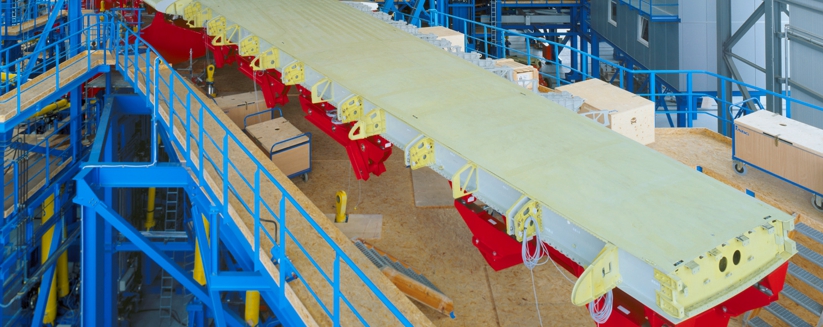
Engines
We can develop a testing concept for every engine or propulsion component according to our customer´s requirements and/or the aviation approval authorities. This mainly also includes the dimensioning of the load introduction structures which simulate the properties or characteristics of the other attachments in the real engine. Materials are often substituted in this case e.g. titanium by steel. We can draw on our extensive experience in this field, not only in design and computation but also with the definition and monitoring of the manufacturing process.
Which loads must be assumed? In particular: How can they be introduced into the structure? These are the central issues which our engineers have to consider. The designed experimental set-ups ensure that the applied forces are distributed correctly. Against the backdrop of economic testing, this means initially that replacement structures (dummy structures) have to be implemented where samples are also elements which are complex systems. Secondly, these dummies must be very close to the original components as far as their strength, resistance and rigidity are concerned.
We can provide scalable systems and adapt them optimally to the respective requirements for measuring and controlling all relevant parameters during the trials. We regularly measure forces, deformation, elongation and strain on the engine components.
Static and dynamic load introduction is possible in the structures. The load or stress components can be forces, temperatures and internal pressure. A test installation was recently put into operation in which the engine component was additionally loaded with forces at 400° C and under an internal pressure of 14 bar.
We utilise diverse software solutions for the evaluation and processing of experimental and trial data. We can provide our customers with the measurement data in appropriate formats which satisfy their requirements. Non-destructive testing procedures enable us to detect damage and document its behaviour during the tests.
Aircraft interior
IMA Dresden executes static and dynamic qualification tests on all types of cabin interiors and attachments. These can range from luggage racks to aircraft kitchenettes up to, and including, complete relaxation cabins for flight attendants and pilots. Customer-specific material requirements and concepts for load distribution can also be considered here. This enables a particularly flexible and fast test execution, also for very large cabin interiors or attachments with a weight of several tons.
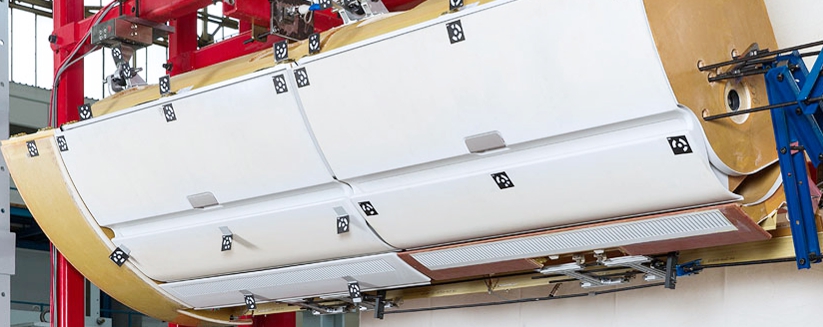
Complete aircrafts (Full-scale)
An essential integral part of any aircraft development is the approval trial on the fuselage sections or the complete cell. The know-how of our engineers for such demanding tasks is based on a long-standing tradition. We were commissioned with the complete development for the fracture trials and the fatigue tests on the wing surfaces of the Fairchild Dornier Do 328JET and the barrel test for the Do728JET model in 1993.
IMA Dresden combines all the necessary competencies for complete cell trials and experiments: In accordance with customer’s requests, we can take on the complete trial development process from planning through to implementation and including comprehensive documentation. We have halls available which are equipped with clamping foundations and sufficiently dimensioned hydraulic and pneumatic infrastructure for large whole cell trials and experiments. Ever-increasing knowledge and modern simulation tools enable us to conceive, design and implement whole cells trials and examinations. We can also provide the necessary scaffolding and load distribution elements (load harnesses, replacement structures etc.) as well as measurement, control, regulating and monitoring systems. We develop load programmes in consultation with the client. We can organise and implement the transportation for larger structures and coordinate all the steps up to, and including, finalising the complete test set up. We can supervise and monitor whole cell trials and experiments with a qualified, multi-shift operation. We can implement all the inspections for the structure on request. We utilise all the available, standard non-destructive testing methods to identify any possible damage. We can create all the documentation as customer-specific in the context of the whole cell test. In addition, we can provide our customers with customised software, for example special damage and inspection database systems.














